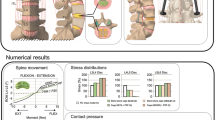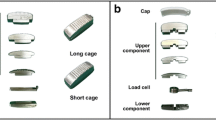Abstract
Interbody cages in the lumbar spine have met with mixed success in clinical studies. This has led many investigators to supplement cages with posterior instrumentation. The objective of this literature review is to address the mechanics of interbody cage fixation in the lumbar spine with respect to three-dimensional stabilization and the strength of the cage-vertebra interface. The effect of supplementary posterior fixation is reviewed. Only three-dimensional stabilization evaluations in human cadaveric models are included. These studies involve the application of different loads to the spine and the measurement of vertebral motion in flexion-extension, axial rotation, and lateral bending. There are no published studies which detected any differences between different cage designs. However, it does seem that cages inserted from an anterior direction provide better stabilization to the spine than those inserted from a posterior direction. In general, anterior cages stabilize better than posterior cages in axial rotation and lateral bending. Cages from both directions stabilized well in flexion, but not in extension. Supplementary posterior fixation with pedicle or translaminar screws substantially improves the stabilization in all directions. The strength of the cage-vertebra interface from studies using human cadaveric specimens is also reviewed. The axial compressive strength of this interface is highly dependent upon vertebral body bone density. Other factors such as preservation of the subchondral bony end-plate and cage design are clearly less important in the compressive strength. Supplementary posterior instrumentation does not enhance substantially the interface strength in axial compression.
Similar content being viewed by others
Author information
Authors and Affiliations
Additional information
Received: 1 September 1999/Accepted: 6 September 1999
Rights and permissions
About this article
Cite this article
Oxland, T., Lund, T. Biomechanics of stand-alone cages and cages in combination with posterior fixation: a literature review. E Spine J 9 (Suppl 1), S095–S101 (2000). https://doi.org/10.1007/PL00010028
Issue Date:
DOI: https://doi.org/10.1007/PL00010028




